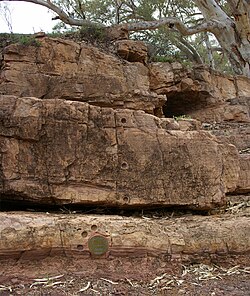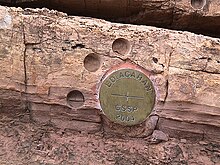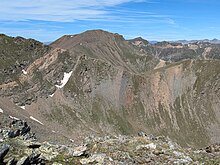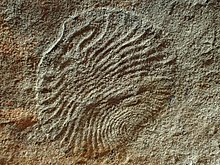Ediacaran
| Ediacaran | ||||||||||||||||||||||||||
|---|---|---|---|---|---|---|---|---|---|---|---|---|---|---|---|---|---|---|---|---|---|---|---|---|---|---|
 A map of Earth as it appeared during the mid-Ediacaran, c. 600 Ma | ||||||||||||||||||||||||||
| Chronology | ||||||||||||||||||||||||||
| ||||||||||||||||||||||||||
| Etymology | ||||||||||||||||||||||||||
| Name formality | Formal | |||||||||||||||||||||||||
| Name ratified | 1990 | |||||||||||||||||||||||||
| Usage information | ||||||||||||||||||||||||||
| Celestial body | Earth | |||||||||||||||||||||||||
| Regional usage | Global (ICS) | |||||||||||||||||||||||||
| Time scale(s) used | ICS Time Scale | |||||||||||||||||||||||||
| Definition | ||||||||||||||||||||||||||
| Chronological unit | Period | |||||||||||||||||||||||||
| Stratigraphic unit | System | |||||||||||||||||||||||||
| Time span formality | Formal | |||||||||||||||||||||||||
| Lower boundary definition |
| |||||||||||||||||||||||||
| Lower boundary GSSP | Enorama Creek section, Flinders Ranges, South Australia 31°19′53″S 138°38′00″E / 31.3314°S 138.6334°E | |||||||||||||||||||||||||
| Lower GSSP ratified | March 2004[1] | |||||||||||||||||||||||||
| Upper boundary definition | Appearance of the Ichnofossil Treptichnus pedum | |||||||||||||||||||||||||
| Upper boundary GSSP | Fortune Head section, Newfoundland, Canada 47°04′34″N 55°49′52″W / 47.0762°N 55.8310°W | |||||||||||||||||||||||||
| Upper GSSP ratified | 1992[2] | |||||||||||||||||||||||||
| Atmospheric and climatic data | ||||||||||||||||||||||||||
| Mean atmospheric O2 content | c. 8 vol % (40 % of modern) | |||||||||||||||||||||||||
| Mean atmospheric CO2 content | c. 4500 ppm (16 times pre-industrial) | |||||||||||||||||||||||||
| Mean surface temperature | c. 17 °C (3.5 °C above pre-industrial) | |||||||||||||||||||||||||
The Ediacaran ( /ˌiːdiˈækərən, ˌɛdi-/ EE-dee-AK-ər-ən, ED-ee-)[3] is a geological period of the Neoproterozoic Era that spans 96 million years from the end of the Cryogenian Period at 635 Mya to the beginning of the Cambrian Period at 538.8 Mya.[4] It is the last period of the Proterozoic Eon as well as the last of the so-called "Precambrian supereon", before the beginning of the subsequent Cambrian Period marks the start of the Phanerozoic Eon, where recognizable fossil evidence of life becomes common.
The Ediacaran Period is named after the Ediacara Hills of South Australia, where trace fossils of a diverse community of previously unrecognized lifeforms (later named the Ediacaran biota) were first discovered by geologist Reg Sprigg in 1946.[5] Its status as an official geological period was ratified in 2004 by the International Union of Geological Sciences (IUGS), making it the first new geological period declared in 120 years.[6][7][8] Although the period took namesake from the Ediacara Hills in the Nilpena Ediacara National Park, the type section is actually located in the bed of the Enorama Creek[9] within the Brachina Gorge[10] in the Ikara-Flinders Ranges National Park, at 31°19′53.8″S 138°38′0.1″E / 31.331611°S 138.633361°E, approximately 55 km (34 mi) southeast of the Ediacara Hills fossil site.
The Ediacaran marks the first widespread appearance of complex multicellular fauna following the end of the Cryogenian global glaciation known as the Snowball Earth. The relatively sudden evolutionary radiation event, known as the Avalon Explosion, is represented by now-extinct, relatively simple soft-bodied animal phyla such as Proarticulata (bilaterians with simple articulation, e.g. Dickinsonia and Spriggina), Petalonamae (sea pen-like animals, e.g. Charnia), Aspidella (radial-shaped animals, e.g. Cyclomedusa) and Trilobozoa (animals with tri-radial symmetry, e.g. Tribrachidium). Most of these organisms appeared during or after the Avalon explosion 575 million years ago and died out during the End-Ediacaran extinction event 539 million years ago. Forerunners of some modern animal phyla also appeared during this period, including cnidarians and early bilaterians, as well as mollusc-like Kimberella. Hard-bodied organisms with mineralized shells also began their fossil record in the last few million years of the Ediacaran.[11]
The supercontinent Pannotia formed and broke apart by the end of the period. The Ediacaran also witnessed several glaciation events, such as the Gaskiers and Baykonurian glaciations. The Shuram excursion also occurred during this period, but its glacial origin is unlikely.
Ediacaran vs. Vendian
The Ediacaran Period overlaps but is shorter than the Vendian Period (650 to 543 million years ago), a name that was earlier, in 1952, proposed by Russian geologist and paleontologist Boris Sokolov. The Vendian concept was formed stratigraphically top-down, and the lower boundary of the Cambrian became the upper boundary of the Vendian.[12][13]
Paleontological substantiation of this boundary was worked out separately for the siliciclastic basin (base of the Baltic Stage of the Eastern European Platform[14]) and for the carbonate basin (base of the Tommotian stage of the Siberian Platform).[15] The lower boundary of the Vendian was suggested to be defined at the base of the Varanger (Laplandian) tillites.[13][16]
The Vendian in its type area consists of large subdivisions such as Laplandian, Redkino, Kotlin and Rovno regional stages with the globally traceable subdivisions and their boundaries, including its lower one.
The Redkino, Kotlin and Rovno regional stages have been substantiated in the type area of the Vendian on the basis of the abundant organic-walled microfossils, megascopic algae, metazoan body fossils and ichnofossils.[13][17]
The lower boundary of the Vendian could have a biostratigraphic substantiation as well taking into consideration the worldwide occurrence of the Pertatataka assemblage of giant acanthomorph acritarchs.[16]
Upper and lower boundaries


The Ediacaran Period (c. 635–538.8 Mya) represents the time from the end of global Marinoan glaciation to the first appearance worldwide of somewhat complicated trace fossils (Treptichnus pedum (Seilacher, 1955)).[6]
Although the Ediacaran Period does contain soft-bodied fossils, it is unusual in comparison to later periods because its beginning is not defined by a change in the fossil record. Rather, the beginning is defined at the base of a chemically distinctive carbonate layer that is referred to as a "cap carbonate", because it caps glacial deposits.
This bed is characterized by an unusual depletion of 13C that indicates a sudden climatic change at the end of the Marinoan ice age. The lower global boundary stratotype section (GSSP) of the Ediacaran is at the base of the cap carbonate (Nuccaleena Formation), immediately above the Elatina diamictite in the Enorama Creek section, Brachina Gorge, Flinders Ranges, South Australia.
The GSSP of the upper boundary of the Ediacaran is the lower boundary of the Cambrian on the SE coast of Newfoundland approved by the International Commission on Stratigraphy as a preferred alternative to the base of the Tommotian Stage in Siberia which was selected on the basis of the ichnofossil Treptichnus pedum (Seilacher, 1955). In the history of stratigraphy it was the first case of usage of bioturbations for the System boundary definition.
Nevertheless, the definitions of the lower and upper boundaries of the Ediacaran on the basis of chemostratigraphy and ichnofossils are disputable.[16][18]
Cap carbonates generally have a restricted geographic distribution (due to specific conditions of their precipitation)[vague] and usually siliciclastic sediments laterally replace the cap carbonates in a rather short distance but cap carbonates do not occur above every tillite elsewhere[clarification needed] in the world.
The C-isotope chemostratigraphic characteristics obtained for contemporaneous cap carbonates in different parts of the world may be variable in a wide range owing to different degrees of secondary alteration of carbonates, dissimilar criteria used for selection of the least altered samples, and, as far as the C-isotope data are concerned, due to primary lateral variations of δ l3Ccarb in the upper layer of the ocean.[16][19]
Furthermore, Oman presents in its stratigraphic record a large negative carbon isotope excursion, within the Shuram[20] Formation that is clearly away from any glacial evidence[21] strongly questioning systematic association of negative δ l3Ccarb excursion and glacial events.[22] Also, the Shuram excursion is prolonged and is estimated to last for ~9.0 Myrs.[23]
As to the Treptichnus pedum, a reference ichnofossil for the lower boundary of the Cambrian, its usage for the stratigraphic detection of this boundary is always risky, because of the occurrence of very similar trace fossils belonging to the Treptichnids group well below the level of T. pedum in Namibia, Spain and Newfoundland, and possibly, in the western United States. The stratigraphic range of T. pedum overlaps the range of the Ediacaran fossils in Namibia, and probably in Spain.[16][24]
Subdivisions

The Ediacaran Period is not yet formally subdivided, but a proposed scheme[26] recognises an Upper Ediacaran whose base corresponds with the Gaskiers glaciation, a Terminal Ediacaran Stage starting around 550 million years ago, a preceding stage beginning around 575 Ma with the earliest widespread Ediacaran biota fossils; two proposed schemes differ on whether the lower strata should be divided into an Early and Middle Ediacaran or not, because it is not clear whether the Shuram excursion (which would divide the Early and Middle) is a separate event from the Gaskiers, or whether the two events are correlated.
Absolute dating
The dating of the rock type section of the Ediacaran Period in South Australia has proven uncertain due to lack of overlying igneous material. Therefore, the age range of 635 to 538.8 million years is based on correlations to other countries where dating has been possible. The base age of approximately 635 million years is based on U–Pb (uranium–lead) and Re–Os (rhenium–osmium) dating from Africa, China, North America, and Tasmania.[27][28][29][30][31]
Biota

The fossil record from the Ediacaran Period is sparse, as more easily fossilized hard-shelled animals had yet to evolve. The Ediacaran biota include the oldest definite multicellular organisms (with specialized tissues), the most common types of which resemble segmented worms, fronds, disks, or immobile bags. Auroralumina was a cnidarian.[33][34]
Most members of the Ediacaran biota bear little resemblance to modern lifeforms, and their relationship even with the immediately following lifeforms of the Cambrian explosion is rather difficult to interpret.[35][36] More than 100 genera have been described, and well known forms include Arkarua, Charnia, Dickinsonia, Ediacaria, Marywadea, Cephalonega, Pteridinium, and Yorgia. However, despite the overall enigmaticness of most Ediacaran organisms, some fossils identifiable as hard-shelled agglutinated foraminifera (which are not classified as animals) are known from latest Ediacaran sediments of western Siberia.[37] Sponges recognisable as such also lived during the Ediacaran.[38]
Four different biotic intervals are known in the Ediacaran, each being characterised by the prominence of a unique ecology and faunal assemblage. The first spanned from 635 to around 575 Ma and was dominated by acritarchs known as large ornamented Ediacaran microfossils.[39] The second spanned from around 575 to 560 Ma and was characterised by the Avalon biota. The third spanned from 560 to 550 Ma; its biota has been dubbed the White Sea biota due to many fossils from this time being found along the coasts of the White Sea. The fourth lasted from 550 to 539 Ma and is known as the interval of the Nama biotic assemblage.[40]
There is evidence for a mass extinction during this period from early animals changing the environment,[41] dating to the same time as the transition between the White Sea and the Nama-type biotas.[42][43] Alternatively, this mass extinction has also been theorised to have been the result of an anoxic event.[40]
Astronomical factors
The relative proximity of the Moon at this time meant that tides were stronger and more rapid than they are now. The day was 21.9 ± 0.4 hours, and there were 13.1 ± 0.1 synodic months/year and 400 ± 7 solar days/year.[44]
Documentaries
A few English language documentaries have featured the Ediacaran Period and biota:
- The Time Traveller's Guide To Australia (2012, ABC Science; Part 1 of 4).[45]
- The Geological History of Canada, as part of The Nature of Things series, CBC-SRC; 2011; Eastern Canada.
- The first episode of a BBC documentary titled Life on Earth, with David Attenborough as narrator.
- Another documentary narrated by David Attenborough titled First Life featuring Charnia, Dickinsonia, Spriggina, Funisia, and Kimberella animated in CGI.
- In our time - Ediacara Biota, BBC, 9 July 2009
See also
- List of fossil sites (with link directory)
- Avalon explosion
- End-Ediacaran extinction
References
- ^ Knoll, Andrew H.; Walter, Malcolm R.; Narbonne, Guy M.; Christie-Black, Nicholas (3 March 2006). "The Ediacaran Period: a new addition to the geologic time scale" (PDF). Lethaia. 39 (1): 13–30. Bibcode:2006Letha..39...13K. doi:10.1080/00241160500409223. Retrieved 6 December 2020.
- ^ Brasier, Martin; Cowie, John; Taylor, Michael. "Decision on the Precambrian-Cambrian boundary stratotype" (PDF). Episodes. 17. Retrieved 6 December 2020.
- ^ "Ediacaran". Dictionary.com Unabridged (Online). n.d.
- ^ "Stratigraphic Chart 2022" (PDF). International Stratigraphic Commission. February 2022. Retrieved 20 April 2022.
- ^ Sprigg, Reg. C. (1947). "Early Cambrian (?) jellyfishes from the Flinders Ranges, South Australia". Transactions of the Royal Society of South Australia. 71 (2): 212–224.
- ^ a b A. Knoll, M. Walter, G. Narbonne, and N. Christie-Blick (2004) "The Ediacaran Period: A New Addition to the Geologic Time Scale." Submitted on Behalf of the Terminal Proterozoic Subcommission of the International Commission on Stratigraphy.
- ^ Knoll, A. H.; Walter, MR; Narbonne, G. M; Christie-Blick, N (30 July 2004). "A new period for the geologic time scale" (PDF). Science. 305 (5684): 621–622. doi:10.1126/science.1098803. PMID 15286353. S2CID 32763298.
- ^ Knoll, A. H.; Walter, M. R.; Narbonne, G. M. & Christie-Blick, N. (March 2006). "The Ediacaran Period: A new addition to the geologic time scale" (PDF). Lethaia. 39 (1): 13–30. Bibcode:2006Letha..39...13K. doi:10.1080/00241160500409223. Archived from the original (PDF) on 21 February 2007.
- ^ "Geological time gets a new period: Geologists have added a new period to their official calendar of Earth's history—the first in 120 years". London: BBC. 17 May 2004. Accessed 27 December 2010.
- ^ South Australian Museum Newsletter April 2005 Archived 17 February 2011 at the Wayback Machine Accessed 9 August 2010.
- ^ Grant, S.W. (1990). "Shell structure and distribution of Cloudina, a potential index fossil for the terminal Proterozoic". American Journal of Science. 290-A (290–A): 261–294. PMID 11538690. Archived from the original on 22 May 2011. Retrieved 19 July 2008.
- ^ B. M. Sokolov (1952). "On the age of the old sedimentary cover of the Russian Platform". Izvestiya Akademii Nauk SSSR, Seriya Eologicheskaya. 5: 21–31.
- ^ a b c Sokolov, B.S. (1997). "Essays on the Advent of the Vendian System." 153 pp. KMK Scientific Press, Moscow. (in Russian)
- ^ Sokolov B. S. (1965) "Abstracts of All-Union Symposium on Paleontology of the Precambrian and Early Cambrian." Nauka, Novosibirsk.
- ^ Rozanov, A.Y.; Missarzhevskij, V.V.; Volkova, N.A.; Voronova, L.G.; Krylov, I.N.; Keller, B.M.; Korolyuk, I.K.; Lendzion, K.; Michniak, R.; Pykhova, N.G. & Sidorov, A.D. (1969). "The Tommotian Stage and the problem of the lower boundary of the Cambrian". Trudy Geologičeskogo Instituta AN SSSR. 206: 1–380.
- ^ a b c d e M. A. Fedonkin; B. S. Sokolov; M. A. Semikhatov; N. M. Chumakov (2007). "Vendian versus Ediacaran: priorities, contents, prospectives". Archived from the original on 4 October 2011. In: "The Rise and Fall of the Vendian (Ediacaran) Biota" (PDF). Origin of the Modern Biosphere. Transactions of the International Conference on the IGCP Project 493n Moscow: GEOS. 20–31 August 2007. Archived from the original (PDF) on 22 November 2012. (82mb)
- ^ Khomentovsky, V. V. (2008). "The Yudomian of Siberia, Vendian and Ediacaran systems of the International stratigraphic scale". Stratigraphy and Geological Correlation. 16 (6): 581–598. Bibcode:2008SGC....16..581K. doi:10.1134/S0869593808060014. S2CID 128966206.
- ^ Comments By B. S. Sokolov, M. A. Semikhatov, And M. A. Fedonkin. (2004) Appendix 2 in: "The Ediacaran Period: A New Addition to the Geologic Time Scale." Submitted on Behalf of the Terminal Proterozoic Subcommission of the International Commission on Stratigraphy. pp. 32–34
- ^ Bristow, T. F.; Kennedy, M. J. (2008). "Carbon isotope excursions and the oxidant budget of the Ediacaran atmosphere and ocean" (PDF). Geology. 36 (11): 863–866. Bibcode:2008Geo....36..863B. doi:10.1130/G24968A.1. Archived from the original (PDF) on 7 May 2020. Retrieved 5 May 2007.
- ^ Le Guerroué, E.; Allen, P. A.; Cozzi, A. (2006). "Chemostratigraphic and sedimentological framework of the largest negative carbon isotopic excursion in Earth history: The Neoproterozoic Shuram Formation (Nafun Group, Oman)". Precambrian Research. 146 (1–2): 68–92. Bibcode:2006PreR..146...68L. doi:10.1016/j.precamres.2006.01.007.
- ^ Le Guerroué, E.; Allen, P. A.; Cozzi, A.; Etienne, J. L.; Fanning, C. M. (2006). "50 Myr recovery from the largest negative δ13C excursion in the Ediacaran ocean". Terra Nova. 18 (2): 147–153. Bibcode:2006TeNov..18..147L. doi:10.1111/j.1365-3121.2006.00674.x. S2CID 140710102. Archived from the original on 5 January 2013.
- ^ Le Guerroué, E.; Allen, P. A.; Cozzi, A. (2006). "Parasequence development in the Ediacaran Shuram Formation (Nafun Group, Oman): primary origin stratigraphic test of negative carbon isotopic ratios". Basin Research. 18 (2): 205–220. Bibcode:2006BasR...18..205L. doi:10.1111/j.1365-2117.2006.00292.x. S2CID 128910191. Archived from the original on 5 January 2013.
- ^ Gong, Zheng; Kodama, Kenneth; Li, Yong-Xiang (2017). "Rock magnetic cyclostratigraphy of the Doushantuo Formation, South China and its implications for the duration of the Shuram carbon isotope excursion". Precambrian Research. 289: 62–74. Bibcode:2017PreR..289...62G. doi:10.1016/j.precamres.2016.12.002.
- ^ A. Ragozina, D. Dorjnamjaa, A. Krayushkin, E. Serezhnikova (2008). "Treptichnus pedum and the Vendian-Cambrian boundary Archived 4 October 2011 at the Wayback Machine". 33 Intern. Geol. Congr. August 6–14, 2008, Oslo, Norway. Abstracts. Section HPF 07 Rise and fall of the Ediacaran (Vendian) biota. P. 183.
- ^ B. Laumonier et al., Notice explicative de la feuille Prats-de-Mollo-La-preste (1099) à 1/50 000, BRGM Éditions, Orléans, 2015, pages 22-23 (bC1 - « ...niveau de marbres calcaires et dolomitiques M1...(dans les) hautes vallées de la Ribérole et de la Carança M1 est formé de 2 ou 3 niveaux décamétriques très continus. », ficheinfoterre.brgm.fr.
- ^ Xiao, Shuhai; Narbonne, Guy M.; Zhou, Chuanming; Laflamme, Marc; Grazhdankin, Dmitriy V.; Moczydlowska-Vidal, Malgorzata; Cui, Huan (2016). "Towards an Ediacaran Time Scale: Problems, Protocols, and Prospects". Episodes. 39 (4): 540555. doi:10.18814/epiiugs/2016/v39i4/103886.
- ^ Rooney, Alan D.; Strauss, Justin V.; Brandon, Alan D.; Macdonald, Francis A. (2015). "A Cryogenian chronology: Two long-lasting synchronous Neoproterozoic glaciations". Geology. 43 (5): 459–462. Bibcode:2015Geo....43..459R. doi:10.1130/G36511.1. ISSN 1943-2682.
- ^ Rooney, Alan D.; Yang, Chuan; Condon, Daniel J.; Zhu, Maoyan; Macdonald, Francis A. (1 June 2020). "U-Pb and Re-Os geochronology tracks stratigraphic condensation in the Sturtian snowball Earth aftermath". Geology. 48 (6): 625–629. Bibcode:2020Geo....48..625R. doi:10.1130/G47246.1. ISSN 0091-7613. S2CID 218815302.
- ^ Zhang, Shihong; Jiang, Ganqing; Zhang, Junming; Song, Biao; Kennedy, Martin J.; Christie-Blick, Nicholas (2005). "U-Pb sensitive high-resolution ion microprobe ages from the Doushantuo Formation in south China: Constraints on late Neoproterozoic glaciations". Geology. 33 (6): 473. Bibcode:2005Geo....33..473Z. doi:10.1130/G21418.1. ISSN 0091-7613.
- ^ Schmitz, M.D. (2012), "Radiometric ages used in GTS2012", The Geologic Time Scale, Elsevier, pp. 1045–1082, doi:10.1016/b978-0-444-59425-9.15002-4, ISBN 978-0-444-59425-9, retrieved 2 April 2022
- ^ Calver, C.R.; Crowley, J.L.; Wingate, M.T.D.; Evans, D.A.D.; Raub, T.D.; Schmitz, M.D. (2013). "Globally synchronous Marinoan deglaciation indicated by U-Pb geochronology of the Cottons Breccia, Tasmania, Australia". Geology. 41 (10): 1127–1130. Bibcode:2013Geo....41.1127C. doi:10.1130/G34568.1. ISSN 1943-2682.
- ^ Fedonkin, Mikhail A.; Gehling, James G.; Grey, Kathleen; Narbonne, Guy M.; Vickers-Rich, Patricia (16 March 2007). The Rise of Animals: Evolution and Diversification of the Kingdom Animalia. JHU Press. ISBN 9780801886799. Retrieved 7 August 2022 – via Google Books.
- ^ Dunn, F. S.; Kenchington, C. G.; Parry, L. A.; Clark, J. W.; Kendall, R. S.; Wilby, P. R. (25 July 2022). "A crown-group cnidarian from the Ediacaran of Charnwood Forest, UK". Nature Ecology & Evolution. 6 (8): 1095–1104. Bibcode:2022NatEE...6.1095D. doi:10.1038/s41559-022-01807-x. PMC 9349040. PMID 35879540.
- ^ Amos, Jonathan (25 July 2022). "Ancient fossil is earliest known animal predator". BBC News. Retrieved 7 August 2022.
- ^ Xiao, Shuhai; Laflamme, Marc (January 2009). "On the eve of animal radiation: phylogeny, ecology and evolution of the Ediacara biota". Trends in Ecology & Evolution. 24 (1): 31–40. Bibcode:2009TEcoE..24...31X. doi:10.1016/j.tree.2008.07.015. PMID 18952316. Retrieved 10 November 2022.
- ^ Dunn, Frances S.; Liu, Alexander G. (11 February 2019). "Viewing the Ediacaran biota as a failed experiment is unhelpful". Nature Ecology and Evolution. 3 (4): 512–514. Bibcode:2019NatEE...3..512D. doi:10.1038/s41559-019-0815-4. PMID 30742104. S2CID 59945361. Retrieved 10 November 2022.
- ^ Kontorovich, A. E.; Varlamov, A. I.; Grazhdankin, D. V.; Karlova, G. A.; Klets, A. G.; Kontorovich, V. A.; Saraev, S. V.; Terleev, A. A.; Belyaev, S. Yu.; Varaksina, I. V.; Efimov, A. S. (1 December 2008). "A section of Vendian in the east of West Siberian Plate (based on data from the Borehole Vostok 3)". Russian Geology and Geophysics. 49 (12): 932–939. Bibcode:2008RuGG...49..932K. doi:10.1016/j.rgg.2008.06.012. ISSN 1068-7971.
- ^ Xiao, Shuhai (12 August 2020). "Ediacaran sponges, animal biomineralization, and skeletal reefs". Proceedings of the National Academy of Sciences of the United States of America. 117 (35): 20997–20999. Bibcode:2020PNAS..11720997X. doi:10.1073/pnas.2014393117. ISSN 0027-8424. PMC 7474584. PMID 32817471.
- ^ Cohen, P. A.; Knoll, A. H.; Kodner, R. B. (April 2009). "Large spinose microfossils in Ediacaran rocks as resting stages of early animals". Proceedings of the National Academy of Sciences of the United States of America. 106 (16): 6519–6524. Bibcode:2009PNAS..106.6519C. doi:10.1073/pnas.0902322106. ISSN 0027-8424. PMC 2672526. PMID 19366668.
- ^ a b Evans, Scott D.; Tu, Chenyi; Rizzo, Adriana; Surprenant, Rachel L.; Boan, Phillip C.; McCandless, Heather; Marshall, Nathan; Xiao, Shuhai; Droser, Mary L. (7 November 2022). "Environmental drivers of the first major animal extinction across the Ediacaran White Sea-Nama transition". Proceedings of the National Academy of Sciences of the United States of America. 119 (46): e2207475119. Bibcode:2022PNAS..11907475E. doi:10.1073/pnas.2207475119. hdl:10919/112639. PMC 9674242. PMID 36343248. Retrieved 24 November 2023.
- ^ Laflamme, Marc; Darroch, Simon A. F.; Tweedt, Sarah M.; Peterson, Kevin J.; Erwin, Douglas H. (1 March 2013). "The end of the Ediacara biota: Extinction, biotic replacement, or Cheshire Cat?". Gondwana Research. Geological processes in the Early Earth. 23 (2): 558–573. Bibcode:2013GondR..23..558L. doi:10.1016/j.gr.2012.11.004. ISSN 1342-937X. Retrieved 24 November 2023.
- ^ Darroch, Simon A. F.; Sperling, Erik A.; Boag, Thomas H.; Racicot, Rachel A.; Mason, Sara J.; Morgan, Alex S.; Tweedt, Sarah; Myrow, Paul; Johnston, David T.; Erwin, Douglas H.; Laflamme, Marc (7 September 2015). "Biotic replacement and mass extinction of the Ediacara biota". Proceedings of the Royal Society B: Biological Sciences. 282 (1814): 1–10. Bibcode:2015RSPSB.28251003D. doi:10.1098/rspb.2015.1003. PMC 4571692. PMID 26336166.
- ^ Evidence that Earth's first mass extinction was caused by critters not catastrophe, ScienceDaily
- ^ Williams, George E. (2000). "Geological constraints on the Precambrian history of Earth's rotation and the Moon's orbit". Reviews of Geophysics. 38 (1): 37–60. Bibcode:2000RvGeo..38...37W. CiteSeerX 10.1.1.597.6421. doi:10.1029/1999RG900016. S2CID 51948507.
- ^ Celebrating 50 years of ABC Science Retrieved 18 March 2023.
External links
- "Geological time gets a new period: Geologists have added a new period to their official calendar of Earth's history—the first in 120 years". London: BBC. 17 May 2004.
- "Ediacaran Period". GeoWhen Database. Retrieved 5 January 2006.
- Introduction to the Vendian Period
- Introduction to the Ediacaran Fauna
- transcript – Catalyst (Australian Broadcasting Corporation)
- Mistaken Point Fauna: The Discovery
- Earth's oldest animal ecosystem held in fossils at Nilpena Station in SA outback ABC News, 5 August 2013. Accessed 6 August 2013.
